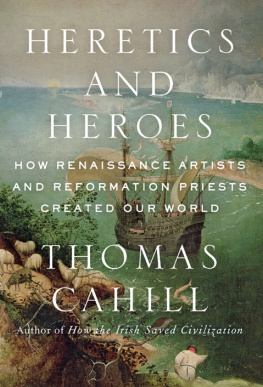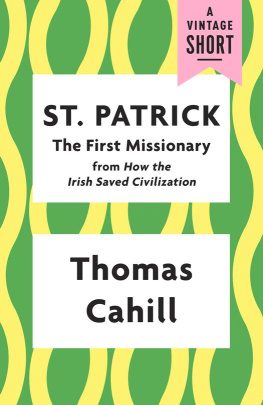JESUS LITTLE INSTRUCTION BOOK
A Bantam Book/October 1994
All rights reserved.
Copyright 1994 by Thomas Cahill
Translation of Philippians 2:6-11 by Thomas Cahill
All other translations from the New Testament are taken from The New Jerusalem Bible, copyright 1985 by Doubleday,
a division of Bantam Doubleday Dell Publishing Group, Inc., and Darton, Longman & Todd, Ltd.
Used by permission of Doubleday.
No part of this book may be reproduced or transmitted in any form or by any means, electronic or mechanical, including photocopying, recording, or by any information storage and retrieval system, without permission in writing from the publisher. For information address: Bantam Books.
Library of Congress Cataloging-in-publication Data
Bible. N.T. Gospels. English. New Jerusalem Bible. Selections. 1994.
Jesus little instruction book: his words to your heart / compiled by Thomas Cahill.
p. cm.
Words of Jesus from the Gospels of Matthew, Mark, and Luke.
eISBN: 978-0-307-80758-8
1. Jesus ChristWords. I. Cahill, Thomas. II. Title.
BT306,C34 1994
226,052076dc20 94-15752
Bantam Books are published by Bantam Books, a division of Bantam Doubleday Dell Publishing Group, Inc. Its trademark, consisting of the words Bantam Books and the portrayal of a rooster, is Registered in U.S. Patent and Trademark Office and in other countries, Marca Registrada, Bantam Books, 1540 Broadway, New York, New York 10036.
v3.1_r1
Contents
T HE W ORDS OF J ESUS F ROM THE G OSPELS OF
M ATTHEW , M ARK, AND L UKE
INTRODUCTION
So far as we know, Jesus never wrote anything downor, if he did, nothing has survived. We are pretty sure he knew how to read and write. The gospels present him as reading aloud from the scroll of the scriptures in the synagogue; and, like other Jewish males of pious family, he would have been schooled as a child to read the Hebrew texts of Judaisms holy books.
But by Jesus day, Hebrew was already a dead language, used principally in study and ritual. The day-to-day language of Jesus and his fellow Jews was Aramaic. The working language of the Roman conquerors who ruled over them was not Latin but Greek, which at that time served as an international languageas Latin would in the Middle Ages and as English does today. So Jesus probably knew some Greek as well, which would have been the language he used to respond to the questions of Pontius Pilate, the Roman procurator who condemned him to death.
Virtually all the sayings of Jesus that have come down to us are written in Greek, and most of these are contained in the four gospels of the New Testament. We know that few, if any, of these sayings can be verbatim, because the great bulk of what Jesus said he said in Aramaic. The Greek sayings of the gospels are translations of Jesus original spoken words (and, as we read them in English, at one more remove from the originals). Furthermore, the gospel writers sometimes contradict one anotherusually in minor detailsby giving different versions of what Jesus said.
Before there were written gospels, there was human memory. Various participants in Jesus life and witnesses to his spoken words joined the communities that formed in his name after his earthly life, and these people contributed their memories of him to the communal pool. One could almost say that memory was the central business of these groups. Informal and fairly unstructured, they met in one anothers houses and tried to keep a low profile, since both Jews and Greeks were suspicious of them. At first, they called themselves followers of the Way, a harmless-sounding phrase. To keep out spies, they used passwords and symbols and secret gestures. If you gained entrance to one of their meetings, you would have found yourself participating in a ritualized common meal at which a portion of the Jewish scriptures was read aloud and interpreted, a hymn was sung that explained the extraordinary significance the singers attached to Jesus life, and bread and wine were distributed with the baffling admonition that these were to be consumed as the body and blood of Jesus himself.
Clearly, this memorial service to Jesus was more than an intellectual exercise. Memory of him had been joined to commitmentcommitment to his Way, surely, but also to the astounding belief that he was still present among his followers, guiding them individually and animating their meeting. Some of the prayers and hymns of these primitive meetings (or churches) have survived, embedded in the books of the New Testament, so we know how they sounded. One hymn, found in Pauls Letter to the Philippians, gives us a succinct summary of what the followers of the Way believed about Jesus:
Though be possessed divine estate
He was not jealous to retain
Equality with God.
He cast off his inheritance,
He took the nature of a slave
And walked as Man among men.
He emptied himself to the last
And was obedient to death
To death upon a cross.
And, therefore, God has raised him up
And God has given him the Name
Which-Is-Above-All-Names,
That at the Name of Jesus all
In heaven high shall bow the knee
And all the earth and depths
And every tongue of men proclaim
That Jesus Christ is L ORD
To the glory of the Father.
Though Jesus was divine, he had taken on our humanity, and had suffered and died for us, emptying himself to the last. This total giving had resulted in his resurrection by the Father God and his exaltation as Lord of the Universe. So the followers of the Way kept the memory of his words and deeds, knowing that his was not the usual human story of life and suffering, ending in death. He was unique in all of history, a man whose life and works had been justified by the act of God himself, who had brought him back from the dead. It was because of this unique proof of the cosmic centrality of Jesus that they wished to remember everything they could about his earthly words and deeds.
But they had another reason for remembering. Jesus himself had urged them to follow himto become like him. How could they? They did not come from God, they could not die on a cross for all humanity. But they could empty themselves, if not of blood, then of all pretension, all worldly ambition, all merely human striving. And they could remember his words and try to live their lives by them.
In this spirit, they began to make collections of his sayings. These collections, the need for which became more pressing as the generation of wit nesses began to pass from the scene, were eventually joined to the oft-told story of Jesus trial, execution, and miraculous resurrection to become written gospels or good spellsthat is, good news. The earliest such gospel may be the Gospel According to Mark, probably committed to papyrus thirty-some years after Jesus crucifixion, perhaps as a written equivalent of the teaching of Peter, the chief apostle. Or it may be that the apostle Matthews Gospel was the firstin a primitive Aramaic version that we have lost. But each of the gospels has several, maybe many, parents. Just imagine all the elders who would have had a story or two to contribute! And when we imagine such interaction, we can easily see how, a full generation or more after the events of Jesus life, some memories would be hard to square with others and some of the stories would have evolved over time to gain a richer meaning than they seemed once to possess. Such a process explains the minor discrepancies among the gospels of Matthew, Mark, and Luke. The Gospel According to John, on the other hand, seems to have been extensively rewritten more than once to make it relevant to the changing conditions (and crises) of the community that produced it. It may not have reached its final form until about the end of the first century.



















